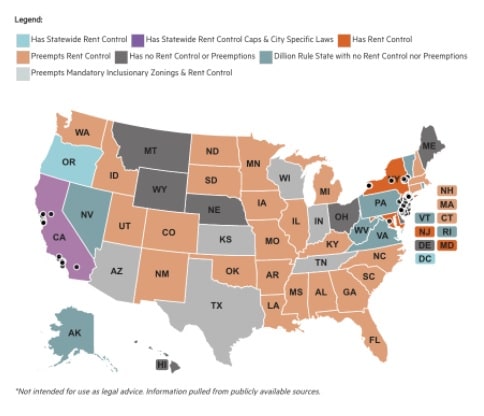
Interested in Rent-Controlled Rentals? Here’s What Tenants Need to Know

Take a look at your monthly budget, and you might be shocked to learn that you’re probably spending way more than a third of your monthly pay just for rent. It eats up a massive chunk of money that could’ve gone to concert tickets, a vacation, or just your rainy day fund. And, while it assures you of a roof over your head, there is a way to find affordable, rent-controlled rentals in certain places of the country.
In this article, we’ll take a look at residential rent control laws and share tips on how to take advantage of them.
What is Rent Control?
Rent control limits how much a landlord can demand when renting a home or renewing a lease. The purpose of this government program is to promote affordable rental housing for residents with a lower income.
Municipalities create the laws for any rent control ordinances, meaning details can vary even within the same state. In fact, the term covers a wide range of regulations.
Here are some variations of rent control:
– Setting a maximum amount of rent with no increases allowed.
– Placing different limits on rent increases (only allowing controlled increases).
– Rules that carry over to the subsequent tenancy or are limited to the duration of an existing tenancy
Because of these differences, similar terms like “rent regulation” and “rent stabilization” have also surfaced in the industry. You don’t have to worry about them, though, as they largely mean the same thing. We’ll also address some of that later on. Instead, what’s important is to familiarize yourself with the local rent control ordinances in your area.
Here’s a map from the National Multifamily Housing Council (NMHC) to see what rent control laws apply to your state:

As you can see, rent-controlled rentals aren’t very common. While there were 2 million rent-controlled homes back in 1950, the number is now closer to 48,248 or 0.11% of total rentals. Nevertheless, there are areas with rent control laws where you can find affordable rental housing units.
Let’s go over the details of rent control and see how it can impact you.
How Does Rent Control Work?
Rent control is more common in cities with limited or expensive housing (e.g., San Francisco and New York). Rent increases in these areas need to follow the guidelines established by some kind of rent control board. As a result, people with lower incomes are able to afford to live in these places.
Here are some terms to familiarize yourself with:
Vacancy Control:Landlords can raise the rent only to a specific limit once the tenant moves out. The increase is limited to a particular amount or percentage each year.
Vacancy Decontrol: Landlords can raise the rent to whatever the market can handle once the tenant moves out. The new rent amount is capped to a particular increase versus the original rent. Once the new tenants come in, they will only pay a limited increase each year.
The keyword here for both of these terms is “vacancy,” meaning landlords have to wait until after the tenant moves out before implementing these rent increases.
If you’re living in New York City, these terminologies also apply:
Rent Control: Rent increases cannot exceed a “maximum base rent,” often covering the landlord’s maintenance costs. This rule only applies to tenants who have been living in the same apartment since 1971 (which is around 1% of their rental units).
Rent Stabilization: Rent increases happen annually and are limited to a particular amount. This rule only applies to buildings constructed before 1974 with at least six units (around 44% of the city’s rental units).
Each city and state has its own way of implementing rent control rules. For example, in New York City, the Rent Guidelines Board discusses and votes on rent control rules each year. In the past decade, the increase hovered between 0% and 4.5% for a one-year lease. In other places like Oregon, where rent control rules apply statewide, they allow a yearly increase of 7% plus inflation.
What are the Pros and Cons of Rent-Controlled Rentals?
While this rule sounds amazing for renters, there are a couple of disadvantages to living in these types of rentals. Here are some things to help you weigh the benefits and risks as a renter:

Conclusion
If you feel that there are more pros than cons, then go ahead and rent that unit. Otherwise, it might be better to hold off on signing the lease. Before deciding between renting an apartment or a home, ensure that you do plenty of research on the specific rent control laws of your city.
As a tenant, there are a lot more things to consider than just the rent. Location, amenities, and your landlord’s personality are all important factors to take into account when finding the right place to live. We hope today’s article helped you learn about another key aspect to look for an apartment or house hunting!
Do you have other concerns about living in rent-controlled homes? Drop them below in the comments section, and we’ll help you out.
Image courtesy of Alexander Mills